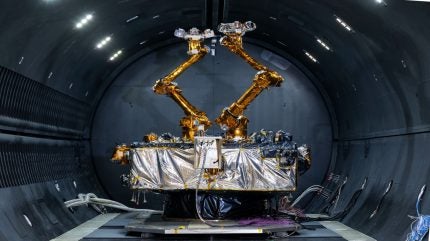
The US Naval Research Laboratory’s (NRL) Naval Center for Space Technology (NCST), in collaboration with the Defense Advanced Research Projects Agency (DARPA), has developed a spaceflight-qualified robotics suite to service satellites in orbit.
DARPA initiated the RSGS programme in 2016 to build a space robot for maintaining geosynchronous satellites and completed all component-level tests by 2022.
RSGS is designed to safely and reliably repair and upgrade valuable commercial, civil, and national security satellites, some of which cost more than $1bn.
With funding from DARPA, NRL developed the Robotic Servicing of Geosynchronous Satellites (RSGS) Integrated Robotic Payload (IRP).
This new space capability has been delivered to Northrop Grumman’s SpaceLogistics, DARPA’s commercial partner, for integration with its spacecraft bus, the mission robotics vehicle (MRV).
The delivery included two robotic arms and electronics for the MRV.
After the robotics payload is fully integrated, the MRV spacecraft will undergo environmental testing.
This process will ensure that the spacecraft performs as expected under conditions similar to those it will encounter in space.
In geosynchronous orbit, MRV will inspect, relocate, repair, and provide in-space servicing, including installing Mission Extension Pods to extend on-orbit capabilities.
SpaceLogistics president Rob Hauge said: “We are creating an in-space servicing infrastructure that has never existed before. Our successful experience in rendezvous, proximity operations and docking has laid the foundation for this critical next step in creating a more sustainable model for future satellite operations.”
As the robotic payload developer for the RSGS programme, NRL focused on designing, building, integrating, and testing new satellite servicing capabilities.
The project aims to enable in-orbit upgrades for satellites based on new technology, extending their service life.
The test campaign subjected the robotic payload to a range of temperatures and vacuum conditions similar to space.
Engineers tested all aspects of the payload, including avionics, cameras, and lights.
The operations of each of its two robotic arms, including launch lock deployments, calibrations, and tool changing, were demonstrated.
The test also verified SpaceWire communications, as well as robotic compliance and visual servo control modes.
NRL has been working for more than 20 years to mature the technology enabling the RSGS programme.
The robotic payload will undergo initial checkout and calibration after its anticipated 2026 launch on Northrop Grumman’s MRV spacecraft bus.
Full operational servicing missions are expected to follow thereafter.



